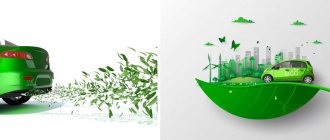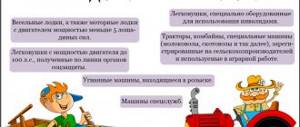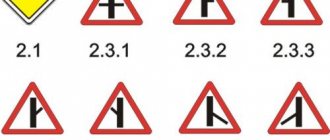Issues discussed in the material:
- What does a car's environmental class mean?
- How did the “ecological automobile transition” begin in Russia?
- What are the environmental classes of cars?
- How to find out the environmental class of a car
- What changes are there in the environmental classes of cars since 2018?
- What is known about the environmental tax
Since Russia is one of the countries party to the Geneva Convention on Road Traffic, our country has legally established standards regarding the composition of exhaust gases. The regulations clearly state that only those vehicles that emit no more than a specified amount of harmful substances into the atmosphere can be used on the territory of the country. In our article we will talk about what the concept of “ecological class of a car” includes and what classes exist today.
What does a car's environmental class mean?
The system for dividing cars into environmental classes is based on research concerning the composition of exhaust gases. It has been established that on average, per year of operation, one machine consumes about four tons of oxygen, and emits the following products of its processing into the air:
- carbon monoxide – about 800 kg;
- carbons – 200 kg;
- nitrogen oxides – 40 kg.
At the same time, according to statistics, there are more and more new cars on the roads every day. Environmental experts are seriously concerned about how the constant increase in toxic emissions will affect the Earth's ecosystem. Naturally, it is not possible to limit the number of private vehicles at the legislative level. Instead, it was decided to introduce standards regarding the maximum content of harmful substances in exhaust gases. Today, all companies that produce cars are required to comply with them.
- Recommended articles:
How to identify a car reseller, and whether it is worth cooperating with themHow to save on gasoline: 30 working ways
Citroen operation: comfort and reliability for 100 years
So, what is the meaning of the concept of environmental class of a car? All vehicles are divided into several categories depending on how much harmful substances they emit into the air during operation. It also takes into account what kind of fuel the car runs on, because evaporation from the fuel also has a destructive effect on the atmosphere.
Harmful fumes include:
- CO – carbon monoxide;
- NO – nitric oxide;
- hydrocarbons;
- fine solids.
An environmental class is assigned to a car when crossing the state border at customs. The car must have a technical passport, which contains a note indicating which class it belongs to.
How it all started
Documents related to the regulation of vehicle emissions of toxic substances began to appear in 1992. Even then, the state of the environment in European countries left much to be desired. The first standard limiting the amount of harmful emissions was called Euro 1. A few years later, a second standard, Euro 2, was adopted, containing even more stringent standards. Subsequently, thanks to the active work of environmental organizations, the third, fourth and fifth editions of environmental standards arose. As a result, in such an issue as environmental classes of cars, the euro is the main standard.
In our country, the first eco-standard for cars was Euro 2, introduced in 2006. Then every two years the document was changed to a newer one. As for cars imported into Russia this year, they must already comply with the most modern standard - Euro 5.
How do car emissions laws affect the lives of ordinary people? First of all, they limit the possibility of importing foreign cars into the country that do not comply with current standards.
Let's explain with an example how this works.
Let's say someone bought a 2003 Citroen car in Europe and wants to transport it to Russia. The problem is that it is impossible to register this car and obtain a technical passport for it. Since the Euro 3 standard was in force in European countries in 2003, and a newer standard is now relevant in Russia, the environmental class of this car is considered outdated. To avoid such a problem, it was necessary to choose a newer Citroen, in the year of production of which the current environmental standard was already in force.
Ecological car classes
Euro-1 is a standard that was the first small step towards protecting the environment from the harmful effects of automobile exhaust. The standards outlined in it applied only to gasoline-powered vehicles. Euro 1 established the maximum possible content of substances such as nitrogen oxide, carbon monoxide and hydrocarbons in exhaust gases. However, these restrictions cannot be called strict.
Euro-2 is the next version of the environmental class of cars, which stipulated that the content of toxic substances in automobile gases should be reduced by three times. In Russia, it was legally recognized in 2005 and began to be used in 2006.
Euro 3 was the first standard that diesel vehicles also had to comply with. The standards regarding the amount of harmful impurities in exhaust gases have become even more stringent here. The maximum content of such substances has decreased by almost 40% compared to the previous edition.
Euro-4 began to be actively used in European countries since 2005, and in the Russian Federation - since 2010. Cars that meet this environmental class must emit another 40% less harmful compounds into the atmosphere than Euro 3 class vehicles.
Euro-5 is the latest edition of the environmental standard. Since 2008, the standards of this edition have become mandatory for trucks, and since 2009 for cars. In 2015, this standard was adopted in our country. At the moment, both in Russia and in all countries of the European Union, only cars of this class are allowed for sale.
After the Euro 5 environmental class of cars became widespread, it became dangerous to purchase vehicles of a different class abroad. Such a car can be imported into a country where the new standard is in force, but it cannot be used for its intended purpose. When entering Russia at customs, you will not receive a technical passport for a Euro 4 or Euro 3 class car, which means you will not be able to register it with the traffic police. This situation will occur regardless of the purpose for which you purchased the car, whether it is a truck or a passenger car, new or used.
The only opportunity to purchase a Euro 4 environmental class car and drive it is to turn to reliable domestic suppliers. If at the time of purchase the car is already in the country and has a valid title, then new documents will not be required, and the car can be driven legally.
Changes in environmental legislation affected not only transport, but also the oil refining industry. All enterprises are now required to use gasoline that complies with Euro 5 standards. This reform has been prepared for quite a long time, and in 2016 all the necessary modernization measures were completed.
So, an environmental class is assigned to each car depending on its characteristics. Both in Russia and in other countries there are regulations related to the use of machines of one class or another. Thus, a number of rules apply to movement in protected areas. Vehicles that emit unacceptable amounts of chemicals into the atmosphere are prohibited from entering protected areas.
Ecological class of a car: how to determine, change or increase
Cars operating in the Russian Federation must comply with the established environmental class. The environmental class of the car, specified in the PTS, confirms compliance with harmful emissions to established standards. Currently, all passenger cars imported into the country must strictly comply with environmental class 5. The environmental class of trucks can be either Euro-0 or Euro-3. To move a truck within the Third Transport Ring (TTK) in Moscow, from September 1, 2015, you need Euro-3, and in order to move along the Moscow Ring Road, you need to comply with the Euro-2 environmental class. Information about the environmental class is contained in the PTS, since the customs authorities registering the car at the border or the manufacturer are required to enter this data on the basis of a certificate of compliance with the environmental standard or OTTS. However, until 2008, this column was absent from the PTS, and the environmental class was not established upon import.
We are increasing the environmental class for cars from 1993. The cost of the service is from 30 thousand rubles.
determine the environmental class yourself using a table developed by the customs service based on data on the year of manufacture and country of origin, as well as other services on the Internet. But only a specially accredited organization can officially (change or increase) the environmental class of a car. The simplest solution to this issue is to issue a certificate of conformity to a certain class at the customs authority when importing a vehicle into the territory of the Russian Federation. If the imported transport does not meet the accepted standard, then its registration with the customs authority is impossible. You can enter the environmental class into the PTS based on data from the customs service, or by converting the vehicle to Euro 2 or Euro 3, respectively.
Changing (increasing) the environmental class is necessary for cars that do not meet the requirements of the law on standards for the content of harmful substances in exhaust gases. From September 1, 2015, Moscow introduced severe sanctions for trucks that do not comply with Euro 2 or Euro 3. Entry into Moscow for such vehicles will be prohibited. How to find out the environmental class and get the opportunity to improve it? This question worries the majority of car owners and entrepreneurs who have trucks older than 2005 in their fleet. The requirements for vehicle emissions of harmful substances in Russia are quite high. Only timely contacting the certification body will make it easier to obtain a mark in the PTS when registering with the traffic police. A certificate of compliance with the environmental class is issued only after a thorough inspection of the vehicle. Our company’s specialists will be happy to answer your questions about the mark in the PTS on compliance with the environmental class. Each case is individual, which is why by turning to professionals you will receive a high level of service.
How to find out the environmental class of a car
Due to changes in regulations, motorists may need to re-equip their vehicle. To understand whether you will have to change the engine or whether it is enough to make changes to the documents, you need to find out what environmental class the car currently has. The list of actions that will allow you to bring the car into compliance with current standards will depend on this.
There are several ways to determine the environmental class of a car:
Examine the vehicle registration certificate.
If you drive a car, you must have a document confirming its registration. There is a line in the new evidence that is called “ecological class”.
In this line, the class number is written in words: fifth, fourth, and so on.
If you have just such a certificate, you can easily find out which class your car belongs to. Then you only need to take into account changes in laws that apply from 2021.
But the new type of STS began to be issued quite recently. In the documents received several years ago, the environmental class was not indicated. If you are the owner of such a certificate, then the restrictions that will come into force in 2021 will apply to your car.
There is one more point: the environmental class of the car may not be indicated in the certificate, but noted in the technical passport. However, according to the new rules, it will still be considered that the class of your vehicle is unknown. Accordingly, all new restrictions will be relevant for you. This situation will upset drivers, especially if they intentionally purchased a car with a high class of environmental safety, but at the time of purchase the corresponding mark had not yet been placed on the certificate.
To avoid problems in the future, you should contact the traffic police and request a new vehicle certificate. You still have time to do this, since the changes will take effect only in a few years. Replacing a car certificate is not difficult: the procedure takes several days, and the fee is 500 rubles for a paper version or 1,500 for a plastic version.
Look in the car's passport.
The passport of any car contains basic data about it, which may include an environmental class number. In documents of the new type there is also a special line for this, where this information is written in words.
In PTS issued several years ago, the environmental class may be indicated in the column for additional information.
If your PTS does not say anything about whether the car belongs to a particular class, refer to the Rosstandart table.
Determine the environmental class of the car using the Rosstandart table.
The environmental class of a car can be determined using a special table. It was compiled by the agency involved in vehicle certification, taking into account the standards in force in the country.
The table takes into account two main criteria: in what year the vehicle was produced and in what country. Among the producers are EU countries, as well as a number of other countries. At the same time, in order for the data in the table to be reliable, the compilers took into account not only UNECE standards, but also local legislative restrictions adopted in each of the designated states.
Although the table was developed in Russia and for Russians, our country is not on the list. The fact is that all environmental standards in the Russian Federation were introduced late compared to European countries, and for a long time they were completely absent. Accordingly, it is impossible to compare a car produced in the early 2000s or earlier in Russia with a similar vehicle imported from Europe.
If you have determined the environmental class of your car using this table, but still have some questions, you can contact the electronic database with your VIN code.
This code can be located on different parts of the car. Most often this is the engine, body pillar near the driver's seat, driver's side dashboard, floor trim, door sill. Also, the identifier can always be found in the passport.
So, to help car enthusiasts, Rosstandart has compiled a table, by studying which you can find out the environmental class of the car. To do this, you need to know only two parameters: where the car was produced and in what year.
The table takes into account the environmental legislation of the EU, the USA and all other countries that are on the list of manufacturers.
Ecological classes of cars: table
| Country of manufacture of the vehicle | Year of manufacture of the vehicle, inclusive | |||
| Do not meet the requirements of standards at the time of import into the Russian Federation (Euro 1 and below) | Meets the requirements of environmental class standards | |||
| Euro2 | Euro3 | Euro4 | ||
| Gasoline, part of the EU | Until 1996 | 1997-2000 | 2001-2004 | 2005+ |
| Gasoline, included in the ESDiesel, included in the EU | Until 1996 | 1997-2000 | 2001-2004 | 2005+ |
| America | Until 1996 | 1997-2001 | 2001-2003 | 2004+ |
| Japan | Until 1997 | 1998-2004 | 2005-2010 | 2011+ |
| Korea | Until 2000 | 2001-2002 | 2003-2005 | 2006+ |
| Canada | Until 2000 | 2001-2003 | 2004+ | — |
| India | Before 2004 | 2005-2009 | 2010+ | — |
| Malaysia | Until 2002 | 2003+ | — | — |
| Russia | — | 2006 | 2008 | 2010+ |
| Ukraine | 2005-2006 | 2006-2007 | ||
If you cannot accurately determine the class of your car from the table (for example, the required country of manufacture is not listed in it), the Rosstandart website will help you. To make an online request, you only need to enter your VIN code.
Use the Rosstandart service, which works by VIN code.
Knowing the VIN code of your vehicle, you can easily find out the necessary information about it. To do this, you need to go to the Rosstandart website, where there is a special service for requesting the environmental class of a car.
The biggest advantage of this method is that you get a completely accurate result. At the same time, using the service is extremely simple: you enter the VIN code numbers, and then study the information from the electronic database. The site will provide you with the following information about the car:
- brand;
- type of transport;
- approval number;
- date of issue of the document and its validity period;
- environmental class number.;
However, this method is not suitable for everyone. Despite the vastness of the electronic database, it still does not contain all possible VIN codes. If information about the environmental class is not in any of your documents, and the above site does not provide it either, the only option is to contact the department in person.
Back in 2013, the Moscow Government developed a bill banning entry into the city for cars with an engine emission class lower than Euro 2. Such measures are dictated by the need to reduce the amount of harmful emissions, 95% of which come from motor vehicles. And from September 1, 2015, the entry into Moscow of trucks that do not meet the Euro 3 environmental class will be prohibited within the Third Transport Ring. The movement of vehicles with an environmental standard of Euro 2 and lower on the Moscow Ring Road is strictly prohibited. Failure to comply with the required environmental class of the vehicle entails administrative liability in the form of deprivation of the right to drive for up to six months. Fines in the amount of 5,000 rubles are also provided if the violation is recorded by video cameras in automatic mode.
Services for changing the environmental class in PTS - from 30,000 rubles
The service completion period is from 2 days.
How to find out (determine) environmental class? There are databases of environmental certificates, OTTS - vehicle type approvals issued earlier, which indicate the environmental class of the car. Determining the environmental class of a vehicle can be done using the database if the VIN number of the vehicle is known. However, the OTTS databases are paid and only certification bodies or customs brokers have access to them. The environmental class of a car by VIN is determined only if the VIN number of the car matches at the level of the first 9 digits. It is important that the engine model matches completely. How to find out the environmental class of a car if the VIN number does not match? You can try entering more numbers. If this does not help, it is necessary to re-equip the engine for Euro 2 or Euro 3, respectively.
If you need to change the environmental class of an engine from Euro 0 and Euro 1 to Euro 2 or Euro 3, then it is necessary to carry out a conversion procedure. Increasing the environmental class of trucks is also possible only by re-equipping the engine. How to make Euro 2 or Euro 3? Changing the environmental class to Euro 2 and Euro 3 is a necessary procedure, without which changes to the PTS are impossible. How to include an environmental class in the PTS? Only after conversion to Euro 2 or Euro 3 has been carried out. Engine conversion is carried out in special accredited organizations, in accordance with UNECE Regulation No. 83 (05.06). It is also possible to increase (change) the environmental class Conversion of a truck engine to Euro 2 and Euro 3 is not sufficient. The certification center must carry out the tests. After all the necessary actions have been carried out, namely engine conversion, a test report is issued. Based on the information in the Test Report, changes are made to the vehicle passport. This mark indicates that the car belongs to the environmental class. The cost of conversion and certification services depends on what environmental class is required.
TABLE OF COMPLIANCE OF TRUCKS AND BUSES WITH ECOLOGICAL CLASSES BY YEAR OF PRODUCTION, ENGINE TYPE OR COUNTRY OF PRODUCTION (DIESEL ENGINES ONLY)
| Vehicle manufacturer country, make, model | Year of manufacture of the truck or bus | |||
| List of vehicles (ICE) corresponding to the EURO-0 environmental class | Compliance of trucks and buses with environmental class (UNECE Rules 83-05, 83-06), GOST-R 581832-2001, methodology of EEC LLC Rules 96) | |||
| EURO 1 | EURO 2 | EURO 3 | ||
| EU countries | until 1997 | 1998-2002 | 2003-2005 | since 2006 |
| United States | until 1998 | 1999-2002 | 2003-2004 | since 2005 |
| Japan, Canada | up to 2000 | 2001-2005 | 2006-2008 | since 2009 |
| Korea, Malaysia | until 2002 | 2003-2006 | 2007-2009 | since 2010 |
| China, UAE, Taiwan | until 2007 | 2008-2009 | 2010-2012 | since 2013 |
| Belarus, Kazakhstan | until 2005 | 2006-2007 | 2008-2010 | since 2011 |
| Brand, model) | Eco-class compliance Russian-made vehicles | |||
| KAMAZ, Russia | until 2004 | 2005-2008 | 2009-2011 | since 2012 |
| MAZ, Belarus | until 2003 | 2004-2006 | 2007-2009 | since 2010 |
| GAZ, Russia | until 2005 | 2006-2009 | 2010-2012 | since 2013 |
| ZIL, Russia | until 2007 | 2007-2010 | 2010-2013 | —— |
| URAL, Russia | until 2010 | 2011-2013 | —— | —— |
Increasing the environmental class of trucks corresponding to the environmental class by one class higher is possible by adjusting the fuel equipment of the vehicle (Methodology of UNECE Regulations 3 96). It is also possible to increase the environmental class by two positions by adjusting the ECM - the electronic engine control system (UNECE Regulation 83-05). Changing the environmental class by three positions is only possible by converting the engine to Euro 2 and Euro 3, respectively. It is usually difficult to enter an environmental class into the PTS that is higher than it actually is. To make appropriate changes to the environmental class PTS, please contact our specialists.
Ecological car class from 2021
Next, we will talk about how traffic rules will change due to new laws from July 1, 2021 and from July 1, 2021. It is planned to introduce a number of new road signs that will one way or another restrict the movement of cars with a high content of harmful substances in their exhaust.
The first stage involves the introduction of signs into operation, and the second - the expansion of the list of cars that will be subject to the designated prohibitions.
- Group of signs “Zone with environmental class restrictions”
In July 2021, the following signs will begin to appear on the roads:
Next to signs 5.35 and 5.36 you can also see sign 8.23, warning about the presence of video recording:
- Valid from July 1, 2021 (if the certificate contains an environmental class mark)
Let's figure out how to interpret each of these signs:
5.35: Passage is prohibited for all vehicles whose environmental class is lower than that required by the sign.
Above you can see an example of such a sign. The minimum environmental class of the car in this case is fourth. Accordingly, cars of the first, second and third classes are prohibited from driving in this zone.
5.36: Similarly establishes the minimum environmental class for trucks, tractors and self-propelled vehicles. Passage is prohibited for vehicles with a lower class.
- Valid from July 1, 2021 (if the certificate does not contain information about the environmental class)
5.35: Passage is prohibited for all vehicles whose environmental class is lower than that required by the sign. This restriction also applies to vehicles whose documents do not say anything about the environmental safety class.
That is, theoretically, in 2021, this ban could affect even a car with the highest environmental class. If the car was purchased before 2010, then the information about the environmental class was not entered into the STS. Having the necessary information in the PTS will not be enough: the car will still be prohibited from entering under this sign.
5.36: Similarly establishes the minimum environmental class for trucks, tractors and self-propelled vehicles. Passage is prohibited both for vehicles with a lower environmental class, and for those whose class is not indicated in the documents.
Signs 5.37 and 5.38 will be installed where prohibitory signs 5.35 and 5.36 end:
- Exceptions for “Zone with Environmental Class Restriction” signs
It is worth noting that a number of vehicles can ignore the prohibition signs 5.35 and 5.36. Among them:
- armed forces vehicles;
- police cars;
- rescue vehicles;
- ambulances;
- emergency transport;
- postal machines with a white diagonal stripe on a blue background on the side surface.
Regardless of what class such a car has and whether it is indicated on the certificate, its movement still cannot be limited by any of the new road signs.
- Vehicle environmental class plate
Also in 2021 a new plate 8.25 will appear:
It can be seen along with a number of familiar signs:
And also with signs:
The signs above are divided into two groups because, when combined with each group, the sign should be understood differently. We will explain this in more detail below.
- Valid from July 1, 2021 (if the certificate contains an environmental class mark)
If you see such a sign next to the sign, then the effect of the signs applies to cars with a lower environmental class than indicated on it.
For example, if the sign has the number 4, then the sign may prohibit (or, conversely, allow) turning for those cars that belong to the first three classes.
Here the meaning will be exactly the opposite. A sign allowing parking in combination with a sign means that only cars of the specified or higher class can stop here.
That is, if you see the number 4 on the sign, then parking is permitted for cars with fourth and fifth environmental safety classes.
- Valid from July 1, 2021 (if the certificate does not contain information about the environmental class)
The principle of operation of the signs remains the same, but their effect will also apply to all vehicles whose certificates do not indicate an environmental class. For example, this sign prohibits turning all cars of the first, second, third, as well as those not installed in the STS class.
From 2021, this combination should be understood as follows: if the environmental class is equal to or greater than the number on the plate, and also if the environmental class is not indicated in the STS, then such a car can park under this sign.
We can say that in this case the restrictions are not tightened, but, on the contrary, softened. If from July 2021 to July 2021 parking under this sign is prohibited for cars with an unknown environmental safety class, then from 2021 it will be allowed.
- Table of actions of signs with environmental class
The table below briefly and clearly explains how the new signs will operate from 2021 and what will change in 2021:
- Fines for violating the requirements of environmental road signs
At the moment, the Administrative Code does not have separate articles relating to violations of the requirements of environmental legislation and environmental road signs in particular. But violators can be fined in accordance with Article 12.16 of the Administrative Code:
12.16 Part 1: warning or fine in the amount of 500 rubles for all violations, except those indicated separately.
12.16 p.2: fine from 1,000 to 1,500 rubles for violating the requirements of a sign prohibiting left turns.
12.16 p.6: 500 rubles for driving trucks with a prohibitory sign (throughout the country, except Moscow and St. Petersburg).
12.16 part 7: 5,000 rubles for a similar violation committed in Moscow or St. Petersburg.
I would like to separately note that the presence in the registration certificate of the environmental class of a passenger car from 2021 will become a key parameter determining whether certain restrictions apply to it. Therefore, car enthusiasts should now think about the need to replace the STS if it does not have the corresponding column.
How can you change the environmental class of a car?
First, it is necessary to outline an important point: if your car does not meet currently accepted standards, then this can only be changed through real modernization. The traffic police will not accept a certificate issued without re-equipping the vehicle. Therefore, you should not contact organizations that promise to easily and quickly solve your problem on paper.
You can increase your car's environmental class to fifth by installing special neutralizers and filters. They reduce fuel consumption, and at the same time the concentration of chemicals in the exhaust decreases.
New signs and, in general, all environmental regulations do not apply to vehicles recognized as self-propelled mechanisms. This means that bulldozers, excavators and other equipment with a maximum speed of up to forty kilometers per hour can ignore prohibitory signs associated with the environmental class.
The driver of such a vehicle can drive under a sign prohibiting cars with a low level of environmental safety from entering or turning.
This exception to the rules was introduced due to the excessively high cost of construction equipment that complies with environmental standards. Numerous bans on the movement of conventional bulldozers and excavators would hamper construction and repair work.
What to do if the environmental class is not specified
Many cars, especially old ones, do not have an environmental class mark in their title. In this case, car owners have two ways to solve the problem.
- You need to contact an official dealer and check with him the environmental class of the engine . If it meets the established standards, the dealer can issue a certificate of conformity (a copy of the OTTS - Vehicle Type Approval). With this document you can arrive at the traffic police MREO and correct the information in the vehicle passport.
- If it was not possible to determine the class or it is below Euro-2 standards, then the environmental class of the car can be increased . To do this, you will have to re-equip the car and reduce the concentration of harmful emissions in the exhaust. Such services are provided by specialized companies.
- The third option is to ignore the problem . Owners of passenger cars are not yet required to have an environmental class mark in their vehicle title; no penalties are provided for the lack of information in the passport.
Read more about environmental classes of cars in Russia
In the Russian Federation, the introduction of new environmental standards occurs much later than in Europe. Until now, on the roads of our country you can find cars that do not meet even the very first Euro 1 standard. Most often, the reason is that the environmental class is simply not specified in any documents. The situation is better in Moscow, where there is a restriction on the entry of cars of low environmental class.
How many cars are there in Russia that meet the most stringent safety standards? These include foreign-made cars starting in 2014, as well as domestic cars produced in 2021 and later. This is due to the fact that manufacturers are focusing on the newer environmental class of the car and producing cars that could comply with rules that have not yet been adopted.
Russian cars with a fourth safety class can still be used in the country without any restrictions. This means that it is worth upgrading such cars only if you are going to travel to European countries.
Change of environmental class in PTS
Changing the environmental class means increasing it to meet modern standards or bringing it into compliance if it has decreased during operation and replacement of engine parts.
Changing the environmental class in the PTS is carried out at the MREO of the State Traffic Safety Inspectorate.
In what cases is it required and possible?
Changing the environmental class may be necessary in the following cases.
- For old cars manufactured before 2008, which do not have an environmental class indicated in the PTS . According to experts, this is up to a third of the country’s entire vehicle fleet.
- For trucks that do not meet Euro-2 standards and enter the capital . In Moscow, since 2013, the entry of cars that do not meet Euro-2 standards has been prohibited. Later, the rules were tightened - trucks with a class below Euro-3 are prohibited from entering the Third Transport Ring. Vehicles with a class lower than Euro-4 are not allowed to enter the Garden Ring. It is planned that in the future additional green zones will be created in Moscow and St. Petersburg, which will also be valid for passenger cars.
What you need
To change the information in the PTS column, you will need to have a document - a certificate of conformity (CTC) from an official dealer or a test examination from a certified company that carried out the conversion of the car to bring emission standards into compliance with Euro standards.
Step by Step Actions
The sequence of actions of a car owner when changing the environmental class is as follows.
- If the car was purchased in Russia, then you need to contact the representative office of the manufacturer to obtain OTTS.
- If the dealer refuses to issue an OTTS, then you need to obtain the results of the examination from a certified organization, on the basis of which the environmental class of the car is established.
- If the class is lower than required, then you need to re-equip the car (adjusting the fuel system, reflashing the engine control system, installing filters and converters). After conversion, you need to obtain an expert opinion with the specified environmental class.
- With a personal passport, documents for the car (PTS, STS, OSAGO policy), expert opinion or OTTS, you need to contact the MREO of the State Traffic Safety Inspectorate to make changes to the PTS.
- You must pay a state fee for making changes to the PTS in the amount of 350 rubles.
- The environmental class mark is affixed within an hour after the application.
Ecology and transport tax
Drivers monitor changes in environmental legislation because transport tax is part of it. So far, the only characteristic of a car that affects the amount of this tax is engine power. At the same time, owners of cars running on electricity are exempt from any fee.
However, in the future, the main criterion may be the environmental class of the car. The Ministry of Transport is developing a bill according to which drivers will pay an environmental fee instead of a transport tax. The higher the safety class of the car and the less its operation harms the environment, the less the owner will have to pay. This system has been in effect for a long time in many developed countries. Due to the difficult environmental situation, the issue of environmental protection comes to the fore, including in the automotive sector. This trend is worth taking into account if you are going to soon purchase a car in Russia or import it from abroad.
How can you determine the environmental class?
If you want to go to another country, you need to go through customs clearance of a used model, for example, from China.
It is important to determine the type of transport. Nothing good will come of it if the imported vehicle does not comply with the rules and only fits parts.
There are three ways to find out the standard:
- Study PTS.
- Use Rosstandart, the country’s agency that carries out certification.
- Find out by VIN.
The first method is to check the technical title. facilities. Most often, the document is available in the home archive and is analyzed only once at the time of receipt.
If the transport has been registered recently, the eco-norm is indicated in line 13 , written in words. There is no need to decrypt.
PTS of vehicles older than five years sometimes has an environmental mark. norm in paragraph “Add. information."
Table for calculating whether a model belongs to standards:
| A country | Years of vehicle production, including: | |||
| Those that do not meet the requirements of technical regulations when imported into Russia (eco-class 1 or less) | Meeting the requirements of technical regulations, by class: | |||
| 2 | 3 | 4 | ||
| EU countries (petrol) | Until 1996 | 97-2000s | 01-04 | from 05 |
| EU countries (diesel engine) | Until 1996 | 97-01 | 02-04 | from 05 |
| USA | Until 1996 | 96-2000 | 01-03 | from 04 |
| Japan | Until 1997 | 97-01 | 05-03 | from 11 |
| Canada | Until 2000 | 01-03 | 04 | – |
| India | Until 2004 | 05-09 | s10 | – |
| Malaysia | Until 2002 | from 03 | – | – |
| China | Until 2003 | 04-07 | from 08 | – |
| Korea | Until 2000 | 01-02 | 03-05 | from 06 |
| Ukraine (M) | Until 2005 | from 06 | – | – |
| Ukraine (N) | Until 2006 | from 07 | – | – |
Using the Rosstandart table is the second method. This is a government organization that deals with certification.
Application of the Rosstandart website: in the form you need to enter the VIN code and send a request .
The system will process and produce the final result:
- brand, model type;
- eco-safety type number;
- the day of signing the certificate that approves the type, the validity period;
- ecotype species.
Sometimes the VIN does not include answers, then you need to contact the Russian Ecoclass yourself.









